Starbucks Corporation: Analysis of Structure, Culture, and Performance
VerifiedAdded on 2023/06/10
|11
|2924
|292
Report
AI Summary
This report provides an in-depth analysis of Starbucks Corporation, focusing on its organizational structure, culture, and current market performance. It begins by defining organizational structure and culture, then examines the specific structures and cultural practices employed by Starbucks, including its matrix organizational structure with functional hierarchy, geographic divisions, product-based divisions, and team-based groups. The report also evaluates the impact of these structures and cultural elements on employee motivation, communication, and overall organizational growth. Furthermore, it discusses Starbucks' servant leadership approach, relationship-driven focus, and commitment to inclusion and diversity. Finally, the report assesses Starbucks' current market position, highlighting its strengths in financial performance, brand image, supply chain management, and product diversity, and offers recommendations for enhancing the company's functional capacity.
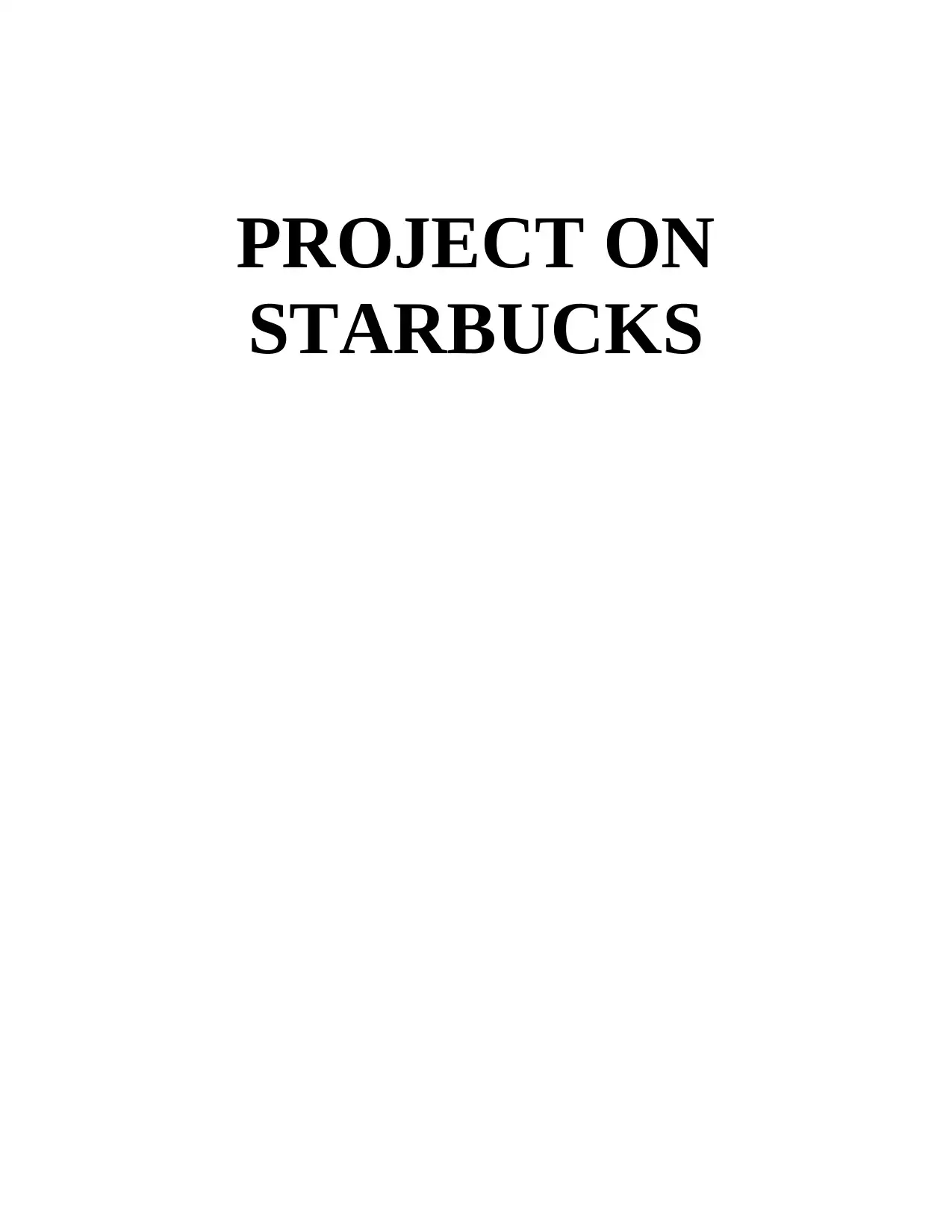
PROJECT ON
STARBUCKS
STARBUCKS
Paraphrase This Document
Need a fresh take? Get an instant paraphrase of this document with our AI Paraphraser
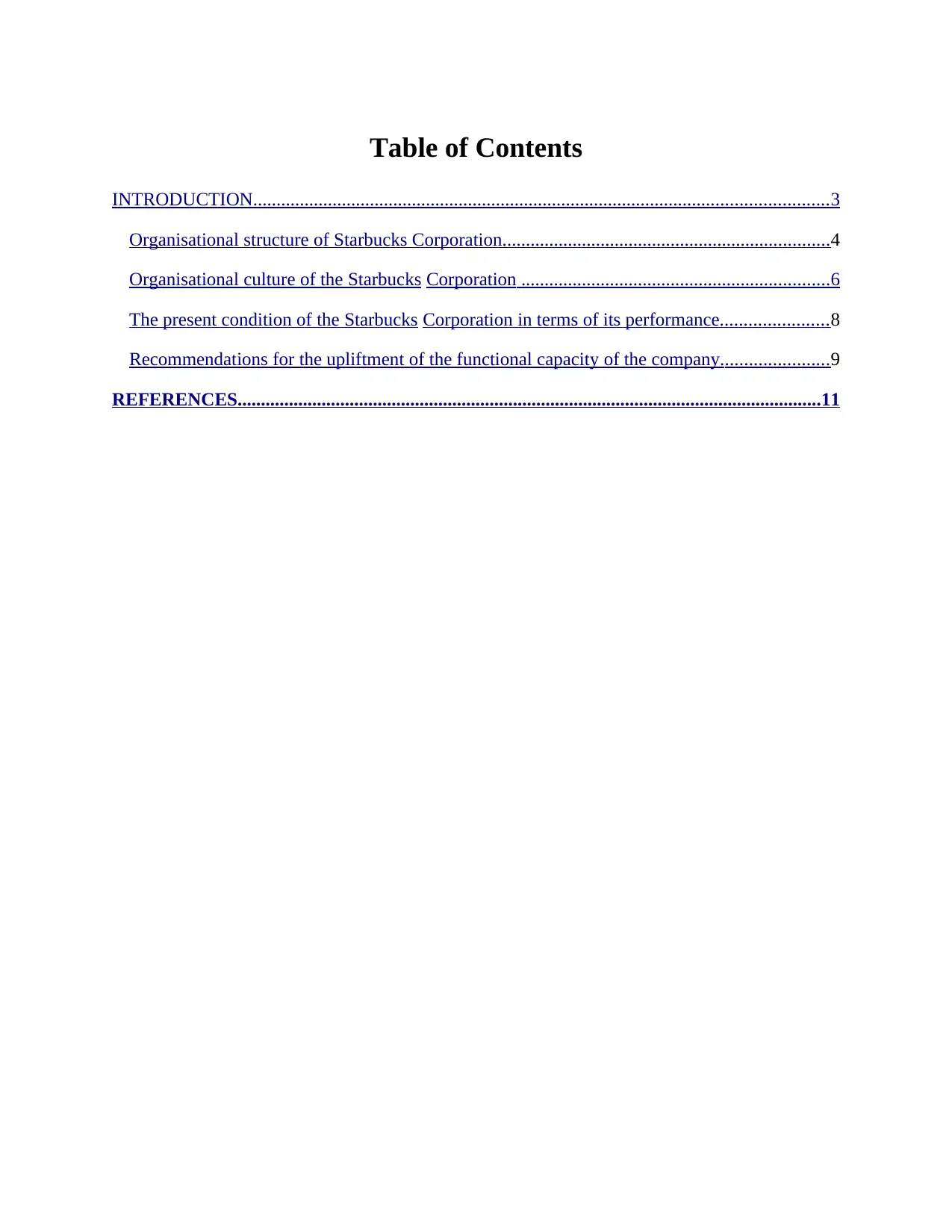
Table of Contents
INTRODUCTION...........................................................................................................................3
Organisational structure of Starbucks Corporation......................................................................4
Organisational culture of the Starbucks Corporation ..................................................................6
The present condition of the Starbucks Corporation in terms of its performance.......................8
Recommendations for the upliftment of the functional capacity of the company.......................9
REFERENCES.............................................................................................................................11
INTRODUCTION...........................................................................................................................3
Organisational structure of Starbucks Corporation......................................................................4
Organisational culture of the Starbucks Corporation ..................................................................6
The present condition of the Starbucks Corporation in terms of its performance.......................8
Recommendations for the upliftment of the functional capacity of the company.......................9
REFERENCES.............................................................................................................................11
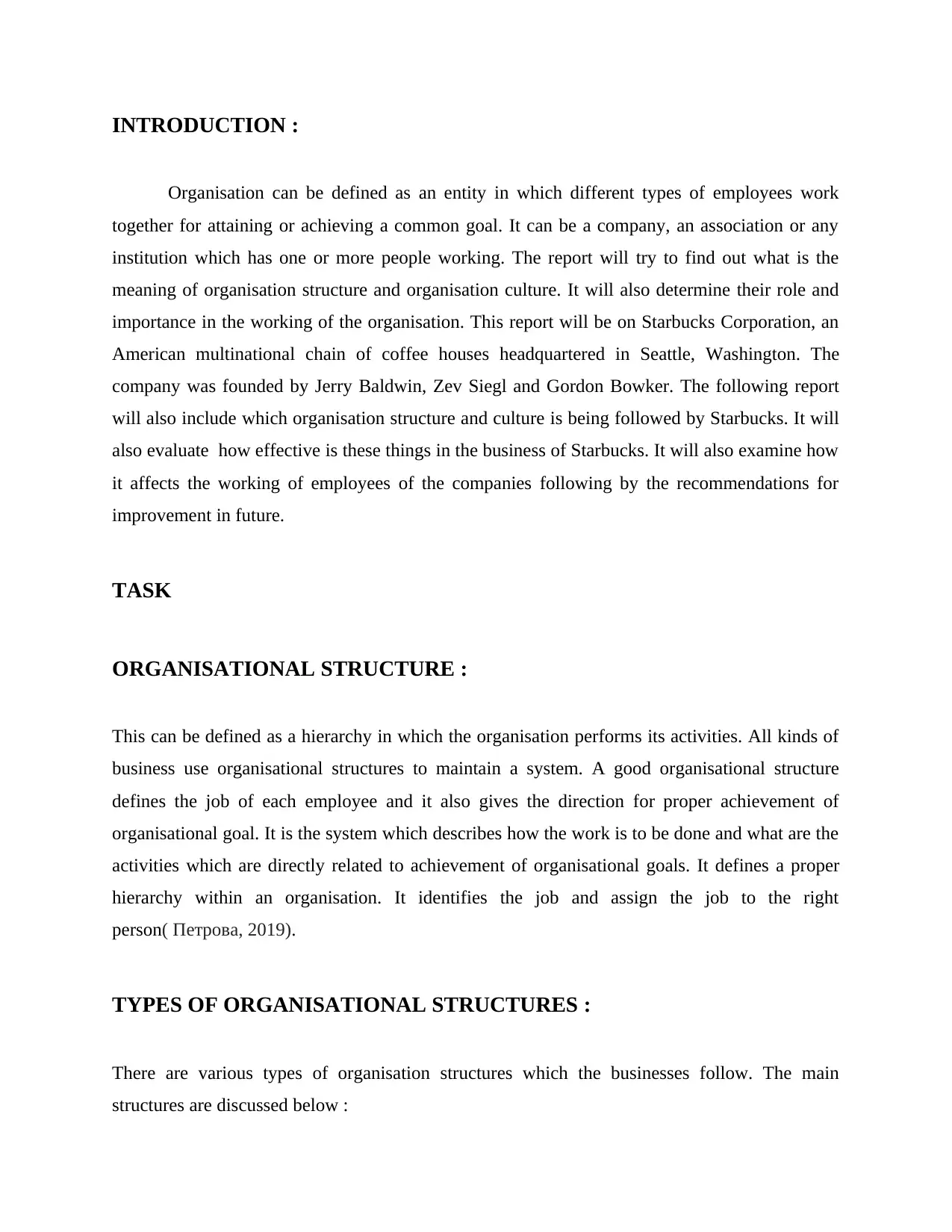
INTRODUCTION :
Organisation can be defined as an entity in which different types of employees work
together for attaining or achieving a common goal. It can be a company, an association or any
institution which has one or more people working. The report will try to find out what is the
meaning of organisation structure and organisation culture. It will also determine their role and
importance in the working of the organisation. This report will be on Starbucks Corporation, an
American multinational chain of coffee houses headquartered in Seattle, Washington. The
company was founded by Jerry Baldwin, Zev Siegl and Gordon Bowker. The following report
will also include which organisation structure and culture is being followed by Starbucks. It will
also evaluate how effective is these things in the business of Starbucks. It will also examine how
it affects the working of employees of the companies following by the recommendations for
improvement in future.
TASK
ORGANISATIONAL STRUCTURE :
This can be defined as a hierarchy in which the organisation performs its activities. All kinds of
business use organisational structures to maintain a system. A good organisational structure
defines the job of each employee and it also gives the direction for proper achievement of
organisational goal. It is the system which describes how the work is to be done and what are the
activities which are directly related to achievement of organisational goals. It defines a proper
hierarchy within an organisation. It identifies the job and assign the job to the right
person( Петрова, 2019).
TYPES OF ORGANISATIONAL STRUCTURES :
There are various types of organisation structures which the businesses follow. The main
structures are discussed below :
Organisation can be defined as an entity in which different types of employees work
together for attaining or achieving a common goal. It can be a company, an association or any
institution which has one or more people working. The report will try to find out what is the
meaning of organisation structure and organisation culture. It will also determine their role and
importance in the working of the organisation. This report will be on Starbucks Corporation, an
American multinational chain of coffee houses headquartered in Seattle, Washington. The
company was founded by Jerry Baldwin, Zev Siegl and Gordon Bowker. The following report
will also include which organisation structure and culture is being followed by Starbucks. It will
also evaluate how effective is these things in the business of Starbucks. It will also examine how
it affects the working of employees of the companies following by the recommendations for
improvement in future.
TASK
ORGANISATIONAL STRUCTURE :
This can be defined as a hierarchy in which the organisation performs its activities. All kinds of
business use organisational structures to maintain a system. A good organisational structure
defines the job of each employee and it also gives the direction for proper achievement of
organisational goal. It is the system which describes how the work is to be done and what are the
activities which are directly related to achievement of organisational goals. It defines a proper
hierarchy within an organisation. It identifies the job and assign the job to the right
person( Петрова, 2019).
TYPES OF ORGANISATIONAL STRUCTURES :
There are various types of organisation structures which the businesses follow. The main
structures are discussed below :
⊘ This is a preview!⊘
Do you want full access?
Subscribe today to unlock all pages.

Trusted by 1+ million students worldwide
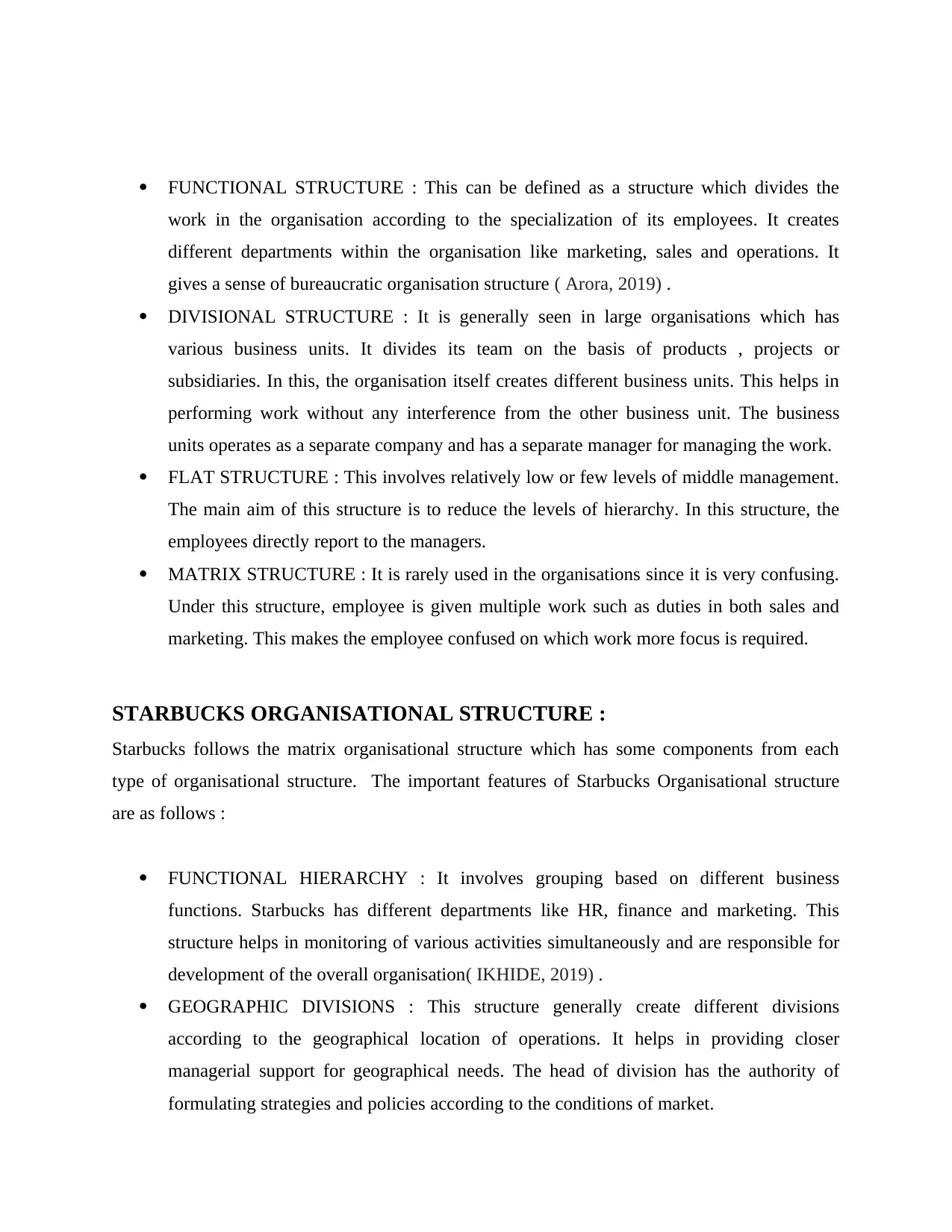
FUNCTIONAL STRUCTURE : This can be defined as a structure which divides the
work in the organisation according to the specialization of its employees. It creates
different departments within the organisation like marketing, sales and operations. It
gives a sense of bureaucratic organisation structure ( Arora, 2019) .
DIVISIONAL STRUCTURE : It is generally seen in large organisations which has
various business units. It divides its team on the basis of products , projects or
subsidiaries. In this, the organisation itself creates different business units. This helps in
performing work without any interference from the other business unit. The business
units operates as a separate company and has a separate manager for managing the work.
FLAT STRUCTURE : This involves relatively low or few levels of middle management.
The main aim of this structure is to reduce the levels of hierarchy. In this structure, the
employees directly report to the managers.
MATRIX STRUCTURE : It is rarely used in the organisations since it is very confusing.
Under this structure, employee is given multiple work such as duties in both sales and
marketing. This makes the employee confused on which work more focus is required.
STARBUCKS ORGANISATIONAL STRUCTURE :
Starbucks follows the matrix organisational structure which has some components from each
type of organisational structure. The important features of Starbucks Organisational structure
are as follows :
FUNCTIONAL HIERARCHY : It involves grouping based on different business
functions. Starbucks has different departments like HR, finance and marketing. This
structure helps in monitoring of various activities simultaneously and are responsible for
development of the overall organisation( IKHIDE, 2019) .
GEOGRAPHIC DIVISIONS : This structure generally create different divisions
according to the geographical location of operations. It helps in providing closer
managerial support for geographical needs. The head of division has the authority of
formulating strategies and policies according to the conditions of market.
work in the organisation according to the specialization of its employees. It creates
different departments within the organisation like marketing, sales and operations. It
gives a sense of bureaucratic organisation structure ( Arora, 2019) .
DIVISIONAL STRUCTURE : It is generally seen in large organisations which has
various business units. It divides its team on the basis of products , projects or
subsidiaries. In this, the organisation itself creates different business units. This helps in
performing work without any interference from the other business unit. The business
units operates as a separate company and has a separate manager for managing the work.
FLAT STRUCTURE : This involves relatively low or few levels of middle management.
The main aim of this structure is to reduce the levels of hierarchy. In this structure, the
employees directly report to the managers.
MATRIX STRUCTURE : It is rarely used in the organisations since it is very confusing.
Under this structure, employee is given multiple work such as duties in both sales and
marketing. This makes the employee confused on which work more focus is required.
STARBUCKS ORGANISATIONAL STRUCTURE :
Starbucks follows the matrix organisational structure which has some components from each
type of organisational structure. The important features of Starbucks Organisational structure
are as follows :
FUNCTIONAL HIERARCHY : It involves grouping based on different business
functions. Starbucks has different departments like HR, finance and marketing. This
structure helps in monitoring of various activities simultaneously and are responsible for
development of the overall organisation( IKHIDE, 2019) .
GEOGRAPHIC DIVISIONS : This structure generally create different divisions
according to the geographical location of operations. It helps in providing closer
managerial support for geographical needs. The head of division has the authority of
formulating strategies and policies according to the conditions of market.
Paraphrase This Document
Need a fresh take? Get an instant paraphrase of this document with our AI Paraphraser
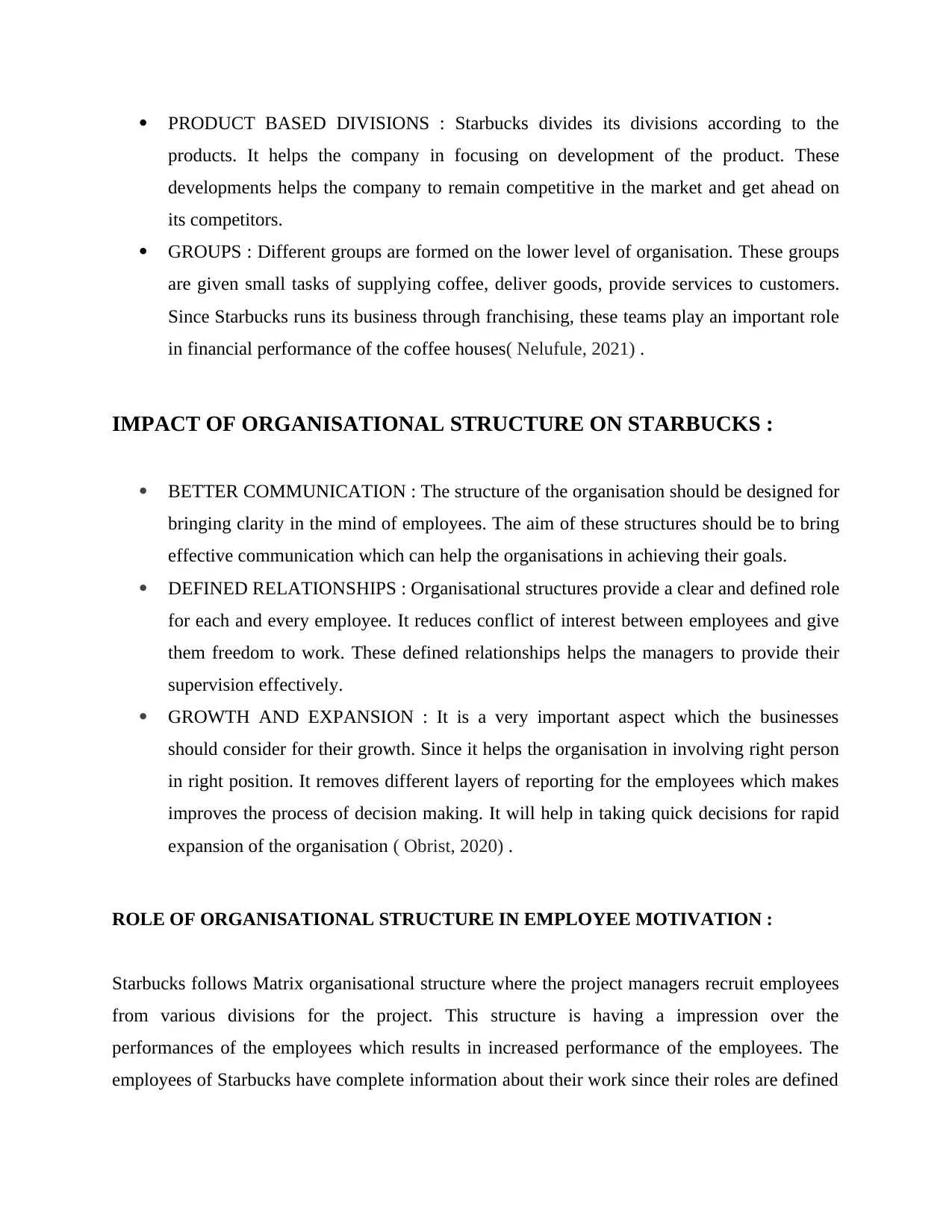
PRODUCT BASED DIVISIONS : Starbucks divides its divisions according to the
products. It helps the company in focusing on development of the product. These
developments helps the company to remain competitive in the market and get ahead on
its competitors.
GROUPS : Different groups are formed on the lower level of organisation. These groups
are given small tasks of supplying coffee, deliver goods, provide services to customers.
Since Starbucks runs its business through franchising, these teams play an important role
in financial performance of the coffee houses( Nelufule, 2021) .
IMPACT OF ORGANISATIONAL STRUCTURE ON STARBUCKS :
BETTER COMMUNICATION : The structure of the organisation should be designed for
bringing clarity in the mind of employees. The aim of these structures should be to bring
effective communication which can help the organisations in achieving their goals.
DEFINED RELATIONSHIPS : Organisational structures provide a clear and defined role
for each and every employee. It reduces conflict of interest between employees and give
them freedom to work. These defined relationships helps the managers to provide their
supervision effectively.
GROWTH AND EXPANSION : It is a very important aspect which the businesses
should consider for their growth. Since it helps the organisation in involving right person
in right position. It removes different layers of reporting for the employees which makes
improves the process of decision making. It will help in taking quick decisions for rapid
expansion of the organisation ( Obrist, 2020) .
ROLE OF ORGANISATIONAL STRUCTURE IN EMPLOYEE MOTIVATION :
Starbucks follows Matrix organisational structure where the project managers recruit employees
from various divisions for the project. This structure is having a impression over the
performances of the employees which results in increased performance of the employees. The
employees of Starbucks have complete information about their work since their roles are defined
products. It helps the company in focusing on development of the product. These
developments helps the company to remain competitive in the market and get ahead on
its competitors.
GROUPS : Different groups are formed on the lower level of organisation. These groups
are given small tasks of supplying coffee, deliver goods, provide services to customers.
Since Starbucks runs its business through franchising, these teams play an important role
in financial performance of the coffee houses( Nelufule, 2021) .
IMPACT OF ORGANISATIONAL STRUCTURE ON STARBUCKS :
BETTER COMMUNICATION : The structure of the organisation should be designed for
bringing clarity in the mind of employees. The aim of these structures should be to bring
effective communication which can help the organisations in achieving their goals.
DEFINED RELATIONSHIPS : Organisational structures provide a clear and defined role
for each and every employee. It reduces conflict of interest between employees and give
them freedom to work. These defined relationships helps the managers to provide their
supervision effectively.
GROWTH AND EXPANSION : It is a very important aspect which the businesses
should consider for their growth. Since it helps the organisation in involving right person
in right position. It removes different layers of reporting for the employees which makes
improves the process of decision making. It will help in taking quick decisions for rapid
expansion of the organisation ( Obrist, 2020) .
ROLE OF ORGANISATIONAL STRUCTURE IN EMPLOYEE MOTIVATION :
Starbucks follows Matrix organisational structure where the project managers recruit employees
from various divisions for the project. This structure is having a impression over the
performances of the employees which results in increased performance of the employees. The
employees of Starbucks have complete information about their work since their roles are defined
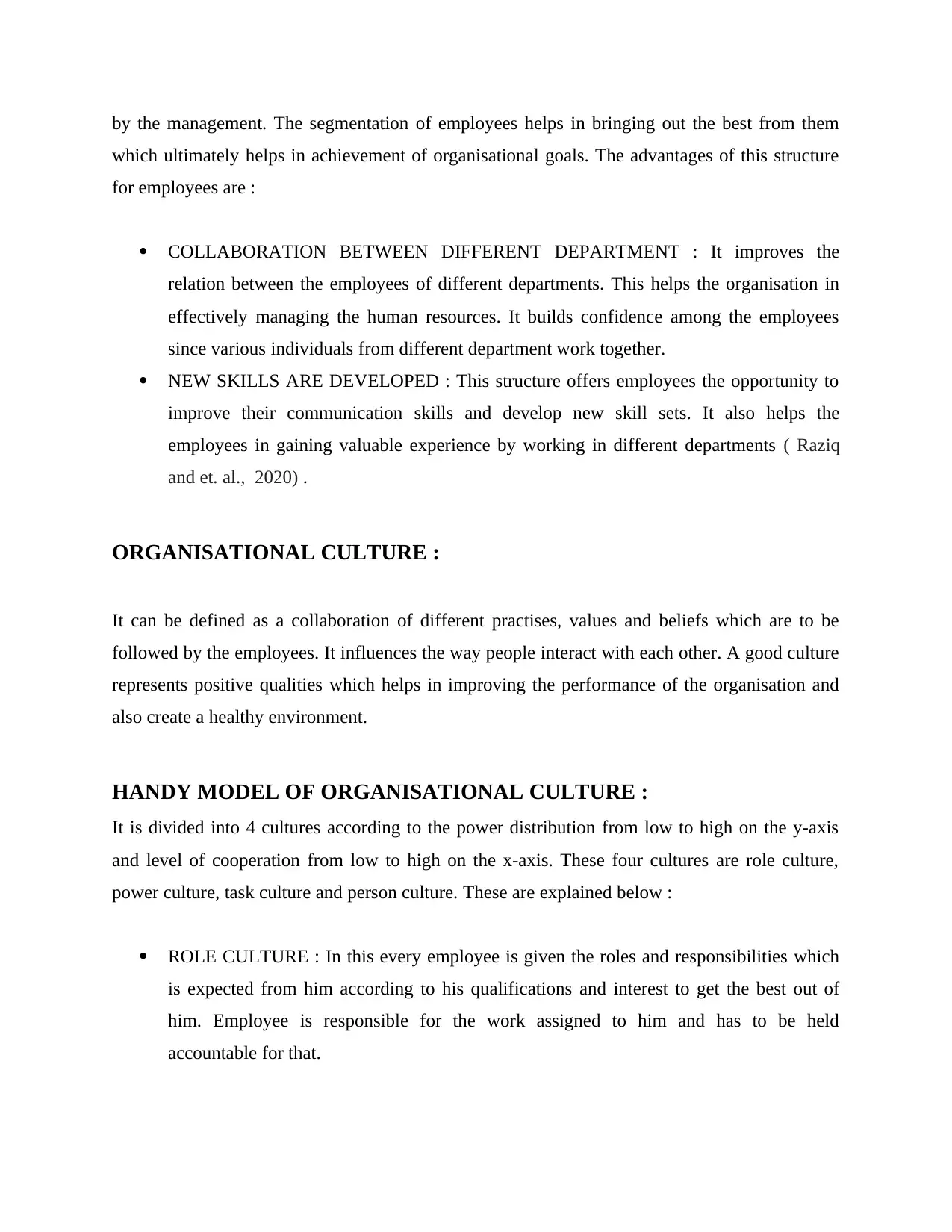
by the management. The segmentation of employees helps in bringing out the best from them
which ultimately helps in achievement of organisational goals. The advantages of this structure
for employees are :
COLLABORATION BETWEEN DIFFERENT DEPARTMENT : It improves the
relation between the employees of different departments. This helps the organisation in
effectively managing the human resources. It builds confidence among the employees
since various individuals from different department work together.
NEW SKILLS ARE DEVELOPED : This structure offers employees the opportunity to
improve their communication skills and develop new skill sets. It also helps the
employees in gaining valuable experience by working in different departments ( Raziq
and et. al., 2020) .
ORGANISATIONAL CULTURE :
It can be defined as a collaboration of different practises, values and beliefs which are to be
followed by the employees. It influences the way people interact with each other. A good culture
represents positive qualities which helps in improving the performance of the organisation and
also create a healthy environment.
HANDY MODEL OF ORGANISATIONAL CULTURE :
It is divided into 4 cultures according to the power distribution from low to high on the y-axis
and level of cooperation from low to high on the x-axis. These four cultures are role culture,
power culture, task culture and person culture. These are explained below :
ROLE CULTURE : In this every employee is given the roles and responsibilities which
is expected from him according to his qualifications and interest to get the best out of
him. Employee is responsible for the work assigned to him and has to be held
accountable for that.
which ultimately helps in achievement of organisational goals. The advantages of this structure
for employees are :
COLLABORATION BETWEEN DIFFERENT DEPARTMENT : It improves the
relation between the employees of different departments. This helps the organisation in
effectively managing the human resources. It builds confidence among the employees
since various individuals from different department work together.
NEW SKILLS ARE DEVELOPED : This structure offers employees the opportunity to
improve their communication skills and develop new skill sets. It also helps the
employees in gaining valuable experience by working in different departments ( Raziq
and et. al., 2020) .
ORGANISATIONAL CULTURE :
It can be defined as a collaboration of different practises, values and beliefs which are to be
followed by the employees. It influences the way people interact with each other. A good culture
represents positive qualities which helps in improving the performance of the organisation and
also create a healthy environment.
HANDY MODEL OF ORGANISATIONAL CULTURE :
It is divided into 4 cultures according to the power distribution from low to high on the y-axis
and level of cooperation from low to high on the x-axis. These four cultures are role culture,
power culture, task culture and person culture. These are explained below :
ROLE CULTURE : In this every employee is given the roles and responsibilities which
is expected from him according to his qualifications and interest to get the best out of
him. Employee is responsible for the work assigned to him and has to be held
accountable for that.
⊘ This is a preview!⊘
Do you want full access?
Subscribe today to unlock all pages.

Trusted by 1+ million students worldwide
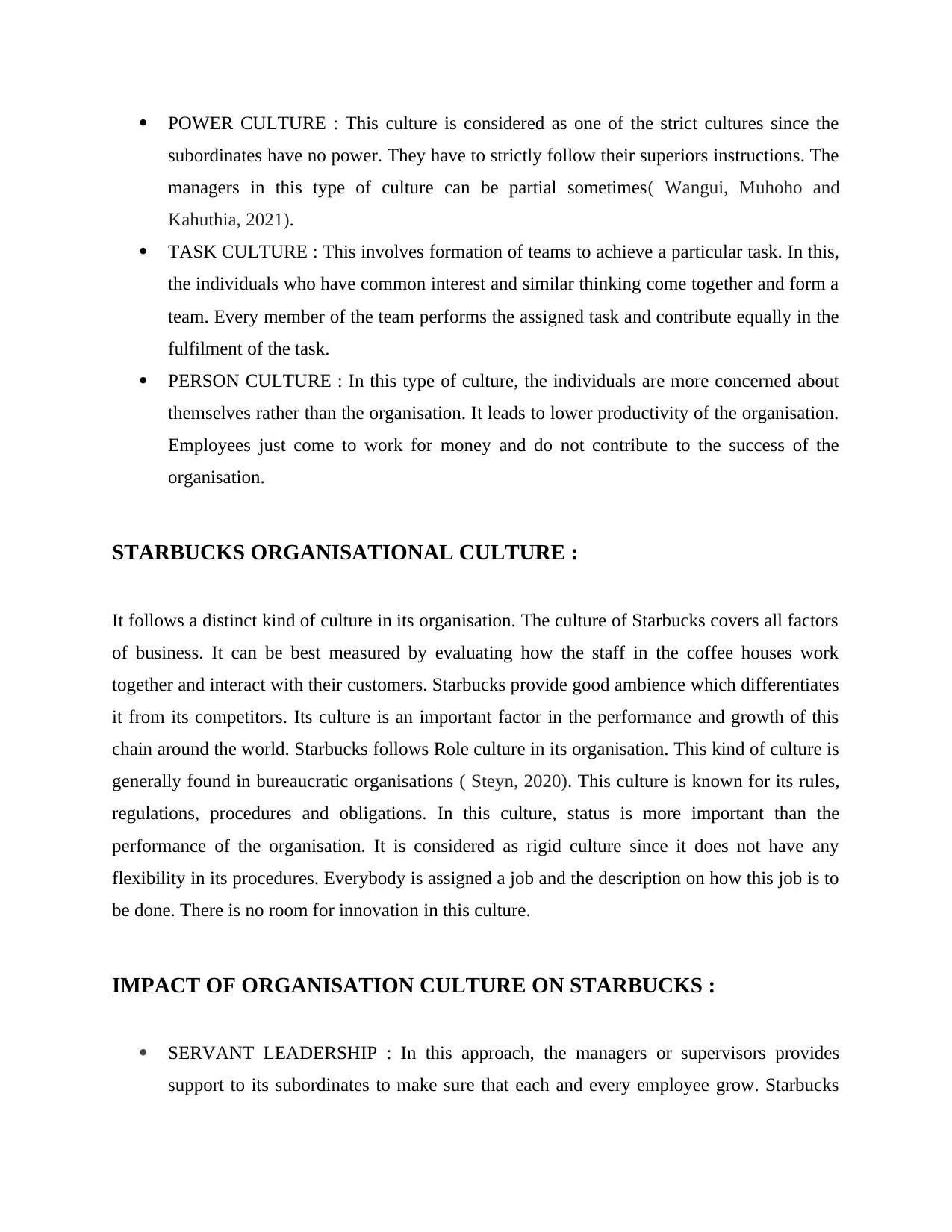
POWER CULTURE : This culture is considered as one of the strict cultures since the
subordinates have no power. They have to strictly follow their superiors instructions. The
managers in this type of culture can be partial sometimes( Wangui, Muhoho and
Kahuthia, 2021).
TASK CULTURE : This involves formation of teams to achieve a particular task. In this,
the individuals who have common interest and similar thinking come together and form a
team. Every member of the team performs the assigned task and contribute equally in the
fulfilment of the task.
PERSON CULTURE : In this type of culture, the individuals are more concerned about
themselves rather than the organisation. It leads to lower productivity of the organisation.
Employees just come to work for money and do not contribute to the success of the
organisation.
STARBUCKS ORGANISATIONAL CULTURE :
It follows a distinct kind of culture in its organisation. The culture of Starbucks covers all factors
of business. It can be best measured by evaluating how the staff in the coffee houses work
together and interact with their customers. Starbucks provide good ambience which differentiates
it from its competitors. Its culture is an important factor in the performance and growth of this
chain around the world. Starbucks follows Role culture in its organisation. This kind of culture is
generally found in bureaucratic organisations ( Steyn, 2020). This culture is known for its rules,
regulations, procedures and obligations. In this culture, status is more important than the
performance of the organisation. It is considered as rigid culture since it does not have any
flexibility in its procedures. Everybody is assigned a job and the description on how this job is to
be done. There is no room for innovation in this culture.
IMPACT OF ORGANISATION CULTURE ON STARBUCKS :
SERVANT LEADERSHIP : In this approach, the managers or supervisors provides
support to its subordinates to make sure that each and every employee grow. Starbucks
subordinates have no power. They have to strictly follow their superiors instructions. The
managers in this type of culture can be partial sometimes( Wangui, Muhoho and
Kahuthia, 2021).
TASK CULTURE : This involves formation of teams to achieve a particular task. In this,
the individuals who have common interest and similar thinking come together and form a
team. Every member of the team performs the assigned task and contribute equally in the
fulfilment of the task.
PERSON CULTURE : In this type of culture, the individuals are more concerned about
themselves rather than the organisation. It leads to lower productivity of the organisation.
Employees just come to work for money and do not contribute to the success of the
organisation.
STARBUCKS ORGANISATIONAL CULTURE :
It follows a distinct kind of culture in its organisation. The culture of Starbucks covers all factors
of business. It can be best measured by evaluating how the staff in the coffee houses work
together and interact with their customers. Starbucks provide good ambience which differentiates
it from its competitors. Its culture is an important factor in the performance and growth of this
chain around the world. Starbucks follows Role culture in its organisation. This kind of culture is
generally found in bureaucratic organisations ( Steyn, 2020). This culture is known for its rules,
regulations, procedures and obligations. In this culture, status is more important than the
performance of the organisation. It is considered as rigid culture since it does not have any
flexibility in its procedures. Everybody is assigned a job and the description on how this job is to
be done. There is no room for innovation in this culture.
IMPACT OF ORGANISATION CULTURE ON STARBUCKS :
SERVANT LEADERSHIP : In this approach, the managers or supervisors provides
support to its subordinates to make sure that each and every employee grow. Starbucks
Paraphrase This Document
Need a fresh take? Get an instant paraphrase of this document with our AI Paraphraser
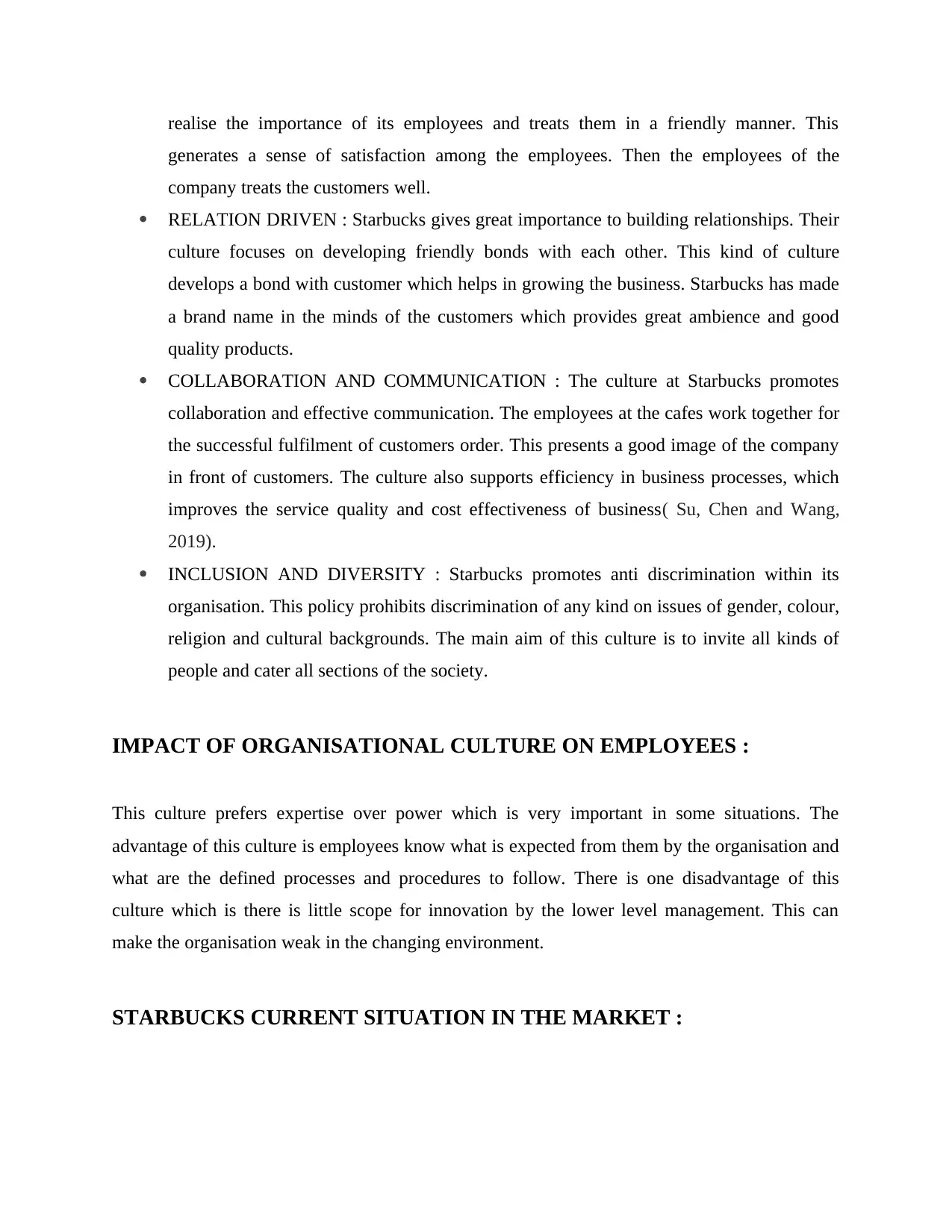
realise the importance of its employees and treats them in a friendly manner. This
generates a sense of satisfaction among the employees. Then the employees of the
company treats the customers well.
RELATION DRIVEN : Starbucks gives great importance to building relationships. Their
culture focuses on developing friendly bonds with each other. This kind of culture
develops a bond with customer which helps in growing the business. Starbucks has made
a brand name in the minds of the customers which provides great ambience and good
quality products.
COLLABORATION AND COMMUNICATION : The culture at Starbucks promotes
collaboration and effective communication. The employees at the cafes work together for
the successful fulfilment of customers order. This presents a good image of the company
in front of customers. The culture also supports efficiency in business processes, which
improves the service quality and cost effectiveness of business( Su, Chen and Wang,
2019).
INCLUSION AND DIVERSITY : Starbucks promotes anti discrimination within its
organisation. This policy prohibits discrimination of any kind on issues of gender, colour,
religion and cultural backgrounds. The main aim of this culture is to invite all kinds of
people and cater all sections of the society.
IMPACT OF ORGANISATIONAL CULTURE ON EMPLOYEES :
This culture prefers expertise over power which is very important in some situations. The
advantage of this culture is employees know what is expected from them by the organisation and
what are the defined processes and procedures to follow. There is one disadvantage of this
culture which is there is little scope for innovation by the lower level management. This can
make the organisation weak in the changing environment.
STARBUCKS CURRENT SITUATION IN THE MARKET :
generates a sense of satisfaction among the employees. Then the employees of the
company treats the customers well.
RELATION DRIVEN : Starbucks gives great importance to building relationships. Their
culture focuses on developing friendly bonds with each other. This kind of culture
develops a bond with customer which helps in growing the business. Starbucks has made
a brand name in the minds of the customers which provides great ambience and good
quality products.
COLLABORATION AND COMMUNICATION : The culture at Starbucks promotes
collaboration and effective communication. The employees at the cafes work together for
the successful fulfilment of customers order. This presents a good image of the company
in front of customers. The culture also supports efficiency in business processes, which
improves the service quality and cost effectiveness of business( Su, Chen and Wang,
2019).
INCLUSION AND DIVERSITY : Starbucks promotes anti discrimination within its
organisation. This policy prohibits discrimination of any kind on issues of gender, colour,
religion and cultural backgrounds. The main aim of this culture is to invite all kinds of
people and cater all sections of the society.
IMPACT OF ORGANISATIONAL CULTURE ON EMPLOYEES :
This culture prefers expertise over power which is very important in some situations. The
advantage of this culture is employees know what is expected from them by the organisation and
what are the defined processes and procedures to follow. There is one disadvantage of this
culture which is there is little scope for innovation by the lower level management. This can
make the organisation weak in the changing environment.
STARBUCKS CURRENT SITUATION IN THE MARKET :
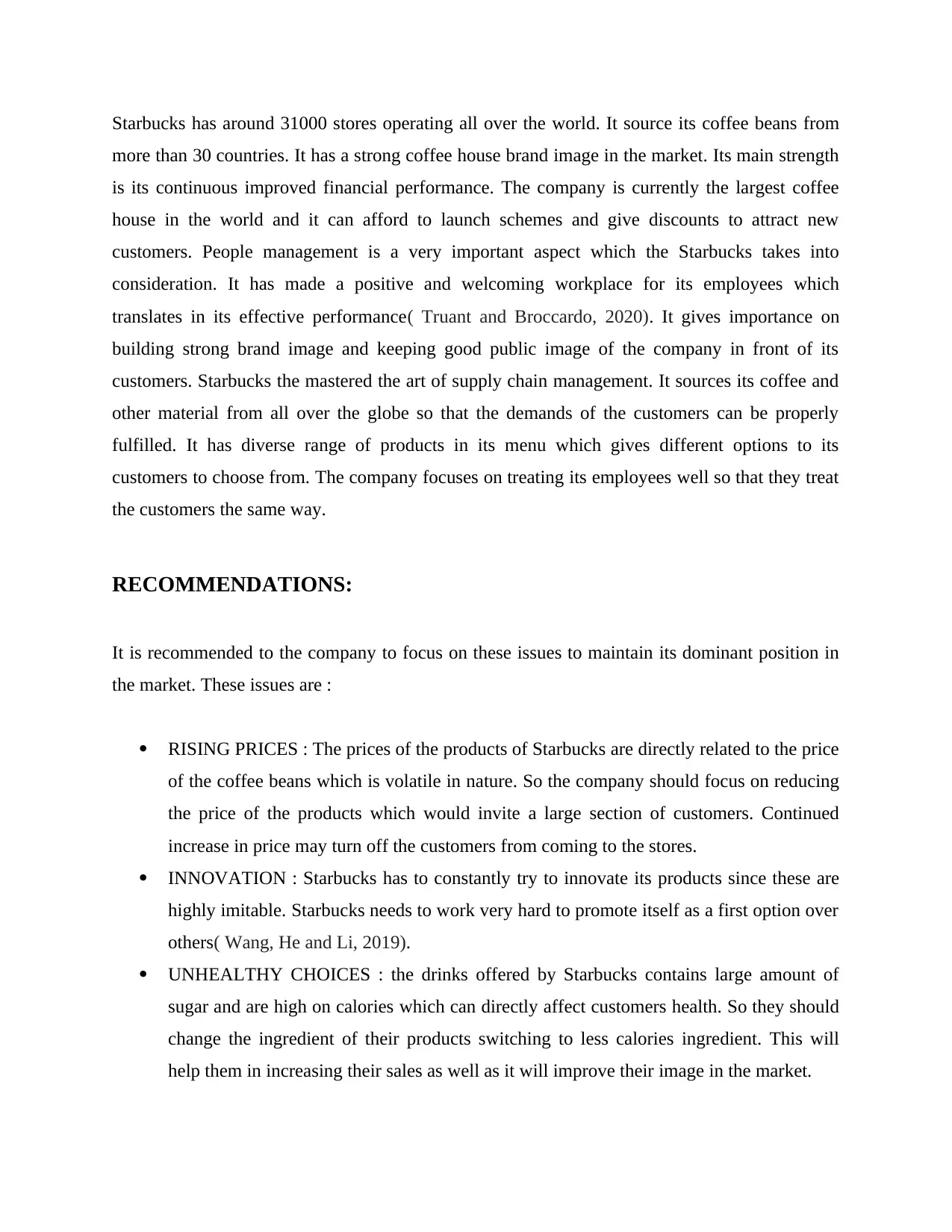
Starbucks has around 31000 stores operating all over the world. It source its coffee beans from
more than 30 countries. It has a strong coffee house brand image in the market. Its main strength
is its continuous improved financial performance. The company is currently the largest coffee
house in the world and it can afford to launch schemes and give discounts to attract new
customers. People management is a very important aspect which the Starbucks takes into
consideration. It has made a positive and welcoming workplace for its employees which
translates in its effective performance( Truant and Broccardo, 2020). It gives importance on
building strong brand image and keeping good public image of the company in front of its
customers. Starbucks the mastered the art of supply chain management. It sources its coffee and
other material from all over the globe so that the demands of the customers can be properly
fulfilled. It has diverse range of products in its menu which gives different options to its
customers to choose from. The company focuses on treating its employees well so that they treat
the customers the same way.
RECOMMENDATIONS:
It is recommended to the company to focus on these issues to maintain its dominant position in
the market. These issues are :
RISING PRICES : The prices of the products of Starbucks are directly related to the price
of the coffee beans which is volatile in nature. So the company should focus on reducing
the price of the products which would invite a large section of customers. Continued
increase in price may turn off the customers from coming to the stores.
INNOVATION : Starbucks has to constantly try to innovate its products since these are
highly imitable. Starbucks needs to work very hard to promote itself as a first option over
others( Wang, He and Li, 2019).
UNHEALTHY CHOICES : the drinks offered by Starbucks contains large amount of
sugar and are high on calories which can directly affect customers health. So they should
change the ingredient of their products switching to less calories ingredient. This will
help them in increasing their sales as well as it will improve their image in the market.
more than 30 countries. It has a strong coffee house brand image in the market. Its main strength
is its continuous improved financial performance. The company is currently the largest coffee
house in the world and it can afford to launch schemes and give discounts to attract new
customers. People management is a very important aspect which the Starbucks takes into
consideration. It has made a positive and welcoming workplace for its employees which
translates in its effective performance( Truant and Broccardo, 2020). It gives importance on
building strong brand image and keeping good public image of the company in front of its
customers. Starbucks the mastered the art of supply chain management. It sources its coffee and
other material from all over the globe so that the demands of the customers can be properly
fulfilled. It has diverse range of products in its menu which gives different options to its
customers to choose from. The company focuses on treating its employees well so that they treat
the customers the same way.
RECOMMENDATIONS:
It is recommended to the company to focus on these issues to maintain its dominant position in
the market. These issues are :
RISING PRICES : The prices of the products of Starbucks are directly related to the price
of the coffee beans which is volatile in nature. So the company should focus on reducing
the price of the products which would invite a large section of customers. Continued
increase in price may turn off the customers from coming to the stores.
INNOVATION : Starbucks has to constantly try to innovate its products since these are
highly imitable. Starbucks needs to work very hard to promote itself as a first option over
others( Wang, He and Li, 2019).
UNHEALTHY CHOICES : the drinks offered by Starbucks contains large amount of
sugar and are high on calories which can directly affect customers health. So they should
change the ingredient of their products switching to less calories ingredient. This will
help them in increasing their sales as well as it will improve their image in the market.
⊘ This is a preview!⊘
Do you want full access?
Subscribe today to unlock all pages.

Trusted by 1+ million students worldwide
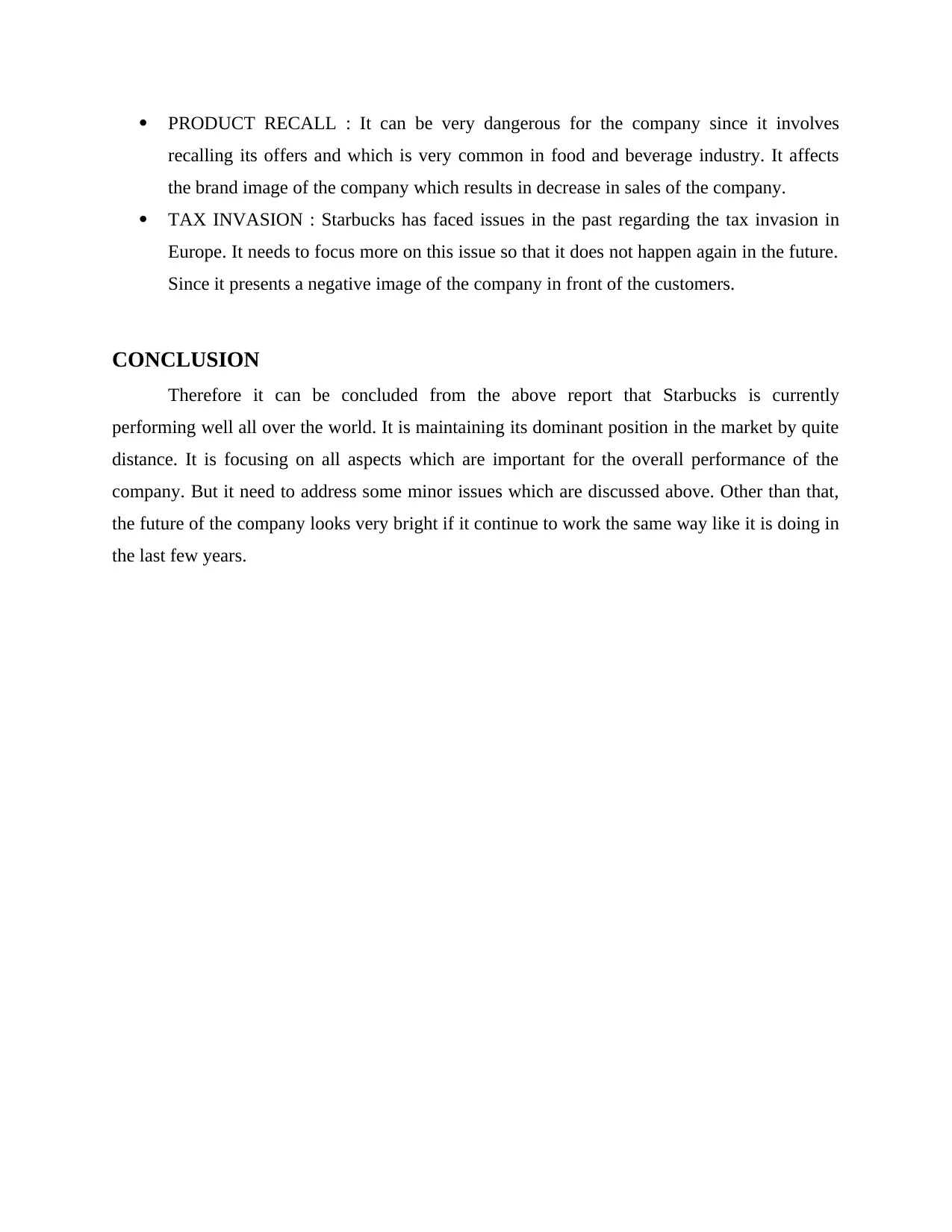
PRODUCT RECALL : It can be very dangerous for the company since it involves
recalling its offers and which is very common in food and beverage industry. It affects
the brand image of the company which results in decrease in sales of the company.
TAX INVASION : Starbucks has faced issues in the past regarding the tax invasion in
Europe. It needs to focus more on this issue so that it does not happen again in the future.
Since it presents a negative image of the company in front of the customers.
CONCLUSION
Therefore it can be concluded from the above report that Starbucks is currently
performing well all over the world. It is maintaining its dominant position in the market by quite
distance. It is focusing on all aspects which are important for the overall performance of the
company. But it need to address some minor issues which are discussed above. Other than that,
the future of the company looks very bright if it continue to work the same way like it is doing in
the last few years.
recalling its offers and which is very common in food and beverage industry. It affects
the brand image of the company which results in decrease in sales of the company.
TAX INVASION : Starbucks has faced issues in the past regarding the tax invasion in
Europe. It needs to focus more on this issue so that it does not happen again in the future.
Since it presents a negative image of the company in front of the customers.
CONCLUSION
Therefore it can be concluded from the above report that Starbucks is currently
performing well all over the world. It is maintaining its dominant position in the market by quite
distance. It is focusing on all aspects which are important for the overall performance of the
company. But it need to address some minor issues which are discussed above. Other than that,
the future of the company looks very bright if it continue to work the same way like it is doing in
the last few years.
Paraphrase This Document
Need a fresh take? Get an instant paraphrase of this document with our AI Paraphraser
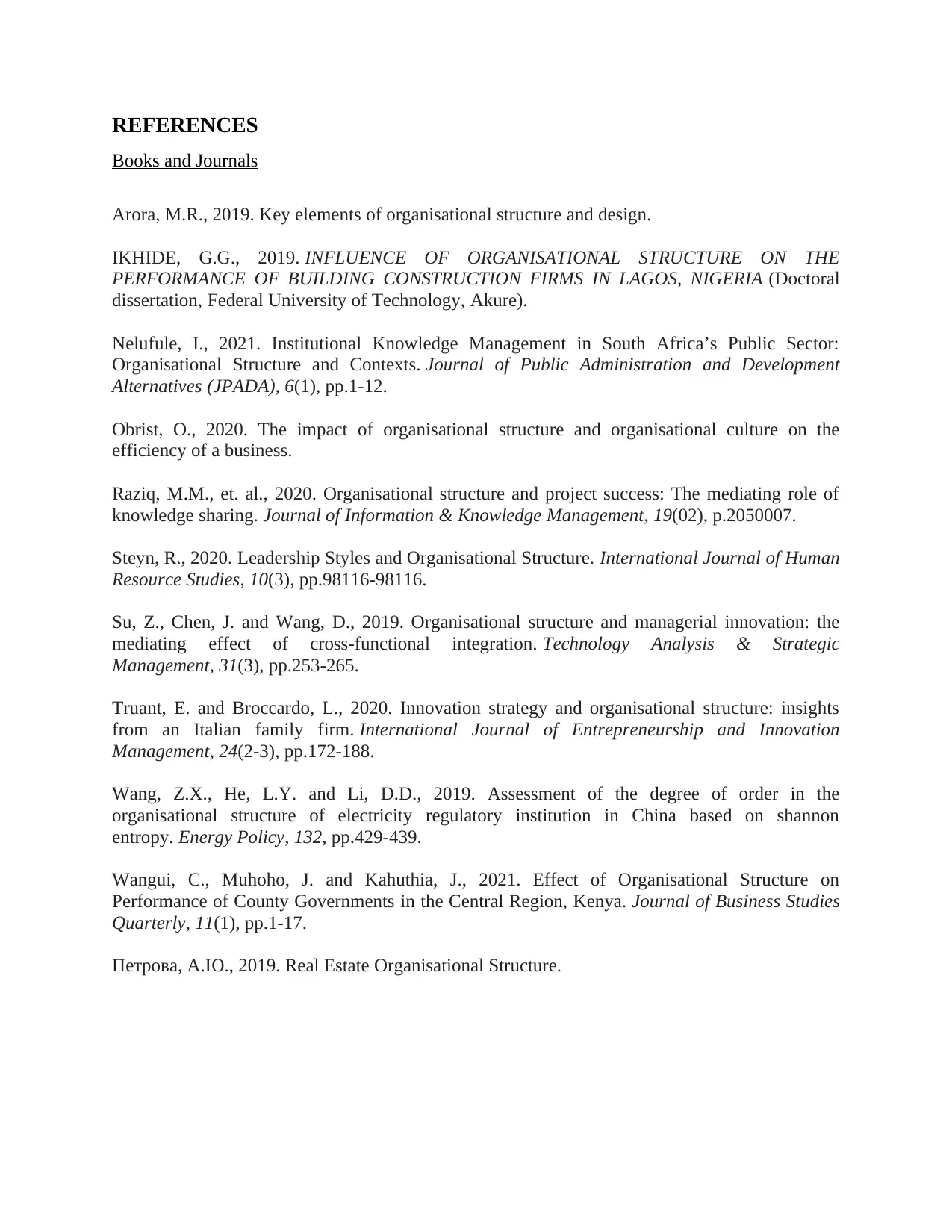
REFERENCES
Books and Journals
Arora, M.R., 2019. Key elements of organisational structure and design.
IKHIDE, G.G., 2019. INFLUENCE OF ORGANISATIONAL STRUCTURE ON THE
PERFORMANCE OF BUILDING CONSTRUCTION FIRMS IN LAGOS, NIGERIA (Doctoral
dissertation, Federal University of Technology, Akure).
Nelufule, I., 2021. Institutional Knowledge Management in South Africa’s Public Sector:
Organisational Structure and Contexts. Journal of Public Administration and Development
Alternatives (JPADA), 6(1), pp.1-12.
Obrist, O., 2020. The impact of organisational structure and organisational culture on the
efficiency of a business.
Raziq, M.M., et. al., 2020. Organisational structure and project success: The mediating role of
knowledge sharing. Journal of Information & Knowledge Management, 19(02), p.2050007.
Steyn, R., 2020. Leadership Styles and Organisational Structure. International Journal of Human
Resource Studies, 10(3), pp.98116-98116.
Su, Z., Chen, J. and Wang, D., 2019. Organisational structure and managerial innovation: the
mediating effect of cross-functional integration. Technology Analysis & Strategic
Management, 31(3), pp.253-265.
Truant, E. and Broccardo, L., 2020. Innovation strategy and organisational structure: insights
from an Italian family firm. International Journal of Entrepreneurship and Innovation
Management, 24(2-3), pp.172-188.
Wang, Z.X., He, L.Y. and Li, D.D., 2019. Assessment of the degree of order in the
organisational structure of electricity regulatory institution in China based on shannon
entropy. Energy Policy, 132, pp.429-439.
Wangui, C., Muhoho, J. and Kahuthia, J., 2021. Effect of Organisational Structure on
Performance of County Governments in the Central Region, Kenya. Journal of Business Studies
Quarterly, 11(1), pp.1-17.
Петрова, А.Ю., 2019. Real Estate Organisational Structure.
Books and Journals
Arora, M.R., 2019. Key elements of organisational structure and design.
IKHIDE, G.G., 2019. INFLUENCE OF ORGANISATIONAL STRUCTURE ON THE
PERFORMANCE OF BUILDING CONSTRUCTION FIRMS IN LAGOS, NIGERIA (Doctoral
dissertation, Federal University of Technology, Akure).
Nelufule, I., 2021. Institutional Knowledge Management in South Africa’s Public Sector:
Organisational Structure and Contexts. Journal of Public Administration and Development
Alternatives (JPADA), 6(1), pp.1-12.
Obrist, O., 2020. The impact of organisational structure and organisational culture on the
efficiency of a business.
Raziq, M.M., et. al., 2020. Organisational structure and project success: The mediating role of
knowledge sharing. Journal of Information & Knowledge Management, 19(02), p.2050007.
Steyn, R., 2020. Leadership Styles and Organisational Structure. International Journal of Human
Resource Studies, 10(3), pp.98116-98116.
Su, Z., Chen, J. and Wang, D., 2019. Organisational structure and managerial innovation: the
mediating effect of cross-functional integration. Technology Analysis & Strategic
Management, 31(3), pp.253-265.
Truant, E. and Broccardo, L., 2020. Innovation strategy and organisational structure: insights
from an Italian family firm. International Journal of Entrepreneurship and Innovation
Management, 24(2-3), pp.172-188.
Wang, Z.X., He, L.Y. and Li, D.D., 2019. Assessment of the degree of order in the
organisational structure of electricity regulatory institution in China based on shannon
entropy. Energy Policy, 132, pp.429-439.
Wangui, C., Muhoho, J. and Kahuthia, J., 2021. Effect of Organisational Structure on
Performance of County Governments in the Central Region, Kenya. Journal of Business Studies
Quarterly, 11(1), pp.1-17.
Петрова, А.Ю., 2019. Real Estate Organisational Structure.
1 out of 11
Related Documents
Your All-in-One AI-Powered Toolkit for Academic Success.
+13062052269
info@desklib.com
Available 24*7 on WhatsApp / Email
![[object Object]](/_next/static/media/star-bottom.7253800d.svg)
Unlock your academic potential
Copyright © 2020–2025 A2Z Services. All Rights Reserved. Developed and managed by ZUCOL.




